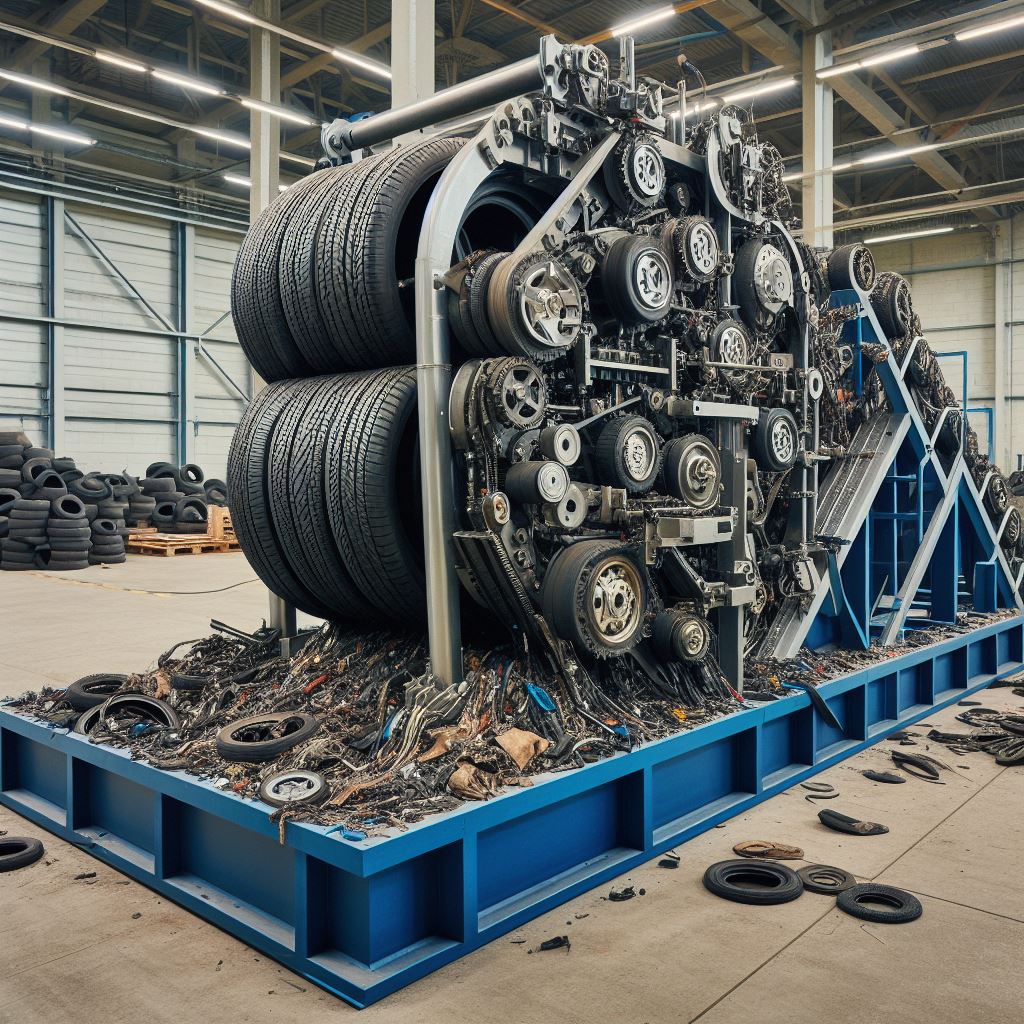Abstract: The present invention pertains to an advanced system for recycling car tires, converting extracted materials into car bumper bars. The Tire-to-Bumper Recycling Machine utilizes cutting-edge technology, comprising innovative components and internal mechanisms. This patent introduces details about the construction materials, internal workings, control panel, computer system, and an onsite reactor generator to offset power consumption. This comprehensive approach enhances the overall efficiency and sustainability of the recycling process.
Description:
1. Construction Materials: The structural integrity of the Tire-to-Bumper Recycling Machine is ensured by employing a combination of lightweight yet durable materials. The exterior framework is primarily constructed from aerospace-grade aluminum alloys, providing a robust yet easily maneuverable frame. Critical components such as the shredder blades and molding molds are composed of a high-tensile carbon composite alloy, enhancing durability and minimizing wear over prolonged use. Internal chambers requiring heat resistance employ a ceramic matrix composite, maintaining structural stability under high-temperature conditions.
2. Internal Workings:
2.1 Tire Shredder:
- The tire shredder features a high-torque electric motor incorporating neodymium rare-earth magnets for enhanced efficiency.
- Utilizes a multi-stage shredding mechanism with dynamically adjustable blade clearances for optimal tire size reduction.
2.2 Sorting Mechanism:
- Employs advanced optical sensors and electromagnetic actuators to precisely identify and separate rubber material from other tire components.
- A conveyor belt system facilitates the smooth transfer of materials within the sorting mechanism.
2.3 Cleaning Unit:
- Water jets with variable pressure settings dislodge impurities, and a cyclonic separator efficiently removes water from the cleaned rubber.
- Air blowers, aided by an electrostatic precipitator, remove finer particles and metal residues from the rubber material.
2.4 Extrusion System:
- High-temperature extrusion is achieved through an induction-heated screw extruder, maintaining precise temperature control.
- Controlled pressure is applied to the rubber, transforming it into a malleable form suitable for molding.
2.5 Molding Station:
- Customizable molds, created using a 3D printing technique with reinforced nanocomposites, shape the recycled rubber into intricate bumper bar designs.
- A precision-controlled hydraulic press ensures uniform molding and consistent quality.
2.6 Curing Chamber:
- The curing chamber utilizes a radiofrequency heating method in conjunction with a vacuum system to expedite the vulcanization process.
- Temperature and pressure are regulated through a PLC-based control system, ensuring optimal curing conditions.
2.7 Quality Control Unit:
- Automated sensors employing spectroscopy and imaging technology inspect the finished bumper bars for structural integrity and quality.
- A machine learning algorithm aids in real-time defect recognition and quality assurance.
2.8 Painting and Finishing Station:
- An automated paint sprayer utilizes nanocomposite coatings for enhanced durability and corrosion resistance.
- Drying chambers equipped with infrared emitters ensure a consistent and rapid curing process.
2.9 Final Assembly Line:
- Conveyor systems integrate finished bumper bars into the automotive manufacturing process.
- Robotic arms equipped with advanced computer vision systems ensure precise placement and integration within car assembly lines.
3. Control Panel and Computer System:
3.1 Control Panel:
- The control panel, located on the machine’s exterior, features a user-friendly interface for operators.
- Touchscreen controls provide real-time monitoring of the recycling process, allowing adjustments to various parameters.
3.2 Computer System:
- A sophisticated computer system, integrated into the control panel, manages the entire recycling process.
- Powered by a high-performance processor, it processes data from sensors, adjusts settings, and ensures the seamless operation of the machine.
4. Onsite Reactor Generator:
4.1 Power Consumption Offset:
- To enhance sustainability, the Tire-to-Bumper Recycling Machine incorporates an onsite reactor generator.
- This generator utilizes advanced nuclear reactor technology, converting a small amount of nuclear fuel into a substantial and clean power source.
4.2 Environmental Impact:
- The use of an onsite reactor generator significantly reduces the machine’s reliance on external power grids, minimizing carbon footprint and contributing to sustainable manufacturing practices.
Advantages:
- Efficiently reduces tire waste and upholds sustainable practices.
- Utilizes lightweight yet durable materials for optimal performance.
- Employs cutting-edge technologies for enhanced precision and automation.
- Adaptable to various bumper designs and sizes for different vehicle models.
- Incorporates a user-friendly control panel and computer system for seamless operation.
- Utilizes an onsite reactor generator to offset power consumption, minimizing environmental impact.
Conclusion: The Tire-to-Bumper Recycling Machine introduces a comprehensive and sustainable approach to recycling car tires, incorporating advanced materials, internal workings, control systems, and an onsite reactor generator. This innovative invention aligns with the current demand for environmentally conscious manufacturing, providing an efficient and technologically advanced method to repurpose discarded materials into high-quality bumper bars while minimizing environmental impact.
